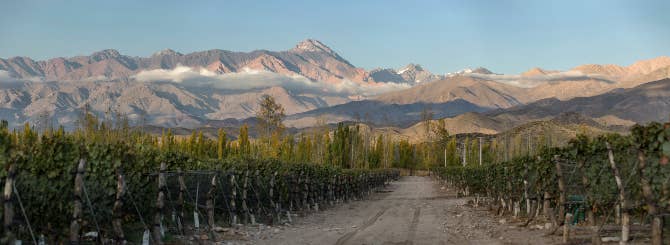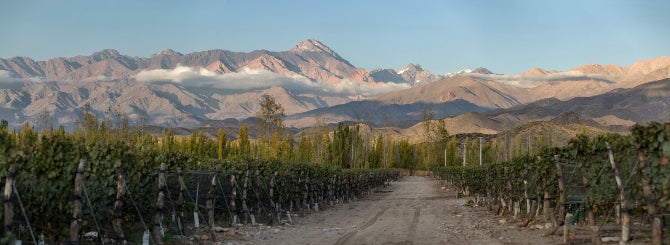Argentina’s Familia Zuccardi is well known for its Malbecs, but its Chardonnays are also exciting our US editor.

© Familia Zuccardi | The high-altitude Finca Las Cuchillas vineyard in San Pablo makes impressive Chardonnay.
Here is something about Argentina you won’t expect: the higher elevation the vineyard, the better it is – for Chardonnay.
That’s what Sebastián Zuccardi thinks, and not many people would know better. In addition to being the third generation of his eponymous family wine business, Zuccardi is trained as both a viticulturist and an agricultural engineer.
First, let’s talk about what high-end Chardonnay from Argentina’s chilly, high-elevation Uco Valley tastes like. It’s tempting to simply call wines like this “Burgundian”, because they’re taut, stony and complex, with flavors ranging from fresh citrus and white peach to smoked ham. Some do remind me of Chablis before climate change; in my notes on one wine I wrote: “This is what Chablis likes to be, and isn’t always.”
I didn’t meet with Sebastián on my visit to Argentina earlier this year; he was out of the country. So nobody told me that he thinks Uco Valley Chardonnay is special. What happened is, I tasted most of Zuccardi’s Uco Valley portfolio. They make some nice Malbecs; of course they do, it’s Argentina. But it was the Chardonnays that really stood out.
I was looking around online for an explanation. Are other people writing about Argentine Chardonnays? Not so much. I stumbled upon a long tasting and interview with Sebastián Zuccardi for the English wine trade magazine The Buyer. That one started with Malbec – it always does. But I came upon this paragraph that perfectly described how I felt tasting the wines:
“Sebastián believes that the greatest revolution in Argentine winemaking is with white wine. Where Semillon used to be the most planted white variety, ‘in the last 15 years we have understood that mountains can make great whites – in the highest plots – and the best grape to express highest altitude is Chardonnay’.”
Zuccardi’s chief viticulturist Martin di Stefano stood in for Sebastián on my visit to the winery, and he gave an interesting presentation about how varied the terroir is in Uco Valley. For one thing, arguably even more than in Burgundy, a short drive from one vineyard to the next brings a huge change in the character of the wines you can produce.
“We can have a one month difference in harvesting Chardonnay from one parcel to the next,” di Stefano said. “To have a one month difference, you should have to drive to Patagonia. But here, we have it in 8 kilometers.”
Some of Zuccardi’s most special plots – notably its Finca Piedra Infinita – are reserved for Malbec. But Zuccardi isn’t treating its Chardonnay the way Argentine wineries treated Semillon for years (planting it wherever they didn’t think Malbec would do well). Zuccardi has vineyards in the chilly San Pablo subregion of Uco Valley that were intended for Chardonnay from the start.
That said, my favorite Zuccardi Chardonnay is from the slightly warmer Gualtallary subregion: the 2023 Zuccardi Botánico Gualtallary Chardonnay. I don’t want to understate this: we don’t publish my scores, but I keep scores. This is the best wine, period, that I have had so far in 2025. That’s not faint praise.
Laura Principiano, Zuccardi’s head winemaker, said part of the reason for the purity and minerally notes of the Chardonnays is fermentation in concrete tanks.
“Other wineries use a lot of stainless steel,” Principiano said. “We started in 2010 with concrete with epoxy lining. After tasting, we decided concrete without epoxy is best. Concrete is a natural material: it allows micro-oxygenation and good temperature control.”
The company does have some older oak tanks, but none of its Chardonnays taste oaky (though there is some nice oak integration on an expensive Semillon I’m going to throw into the tasting notes as a ringer.)
Di Stefano said the company doesn’t move the soils in its vineyards by discing, nor does it use herbicides. The high-elevation parts of Uco Valley aren’t good for any agriculture other than grapevines, and yet there are often large separations between properties, which makes it easier to defend against vineyard pests. All Zuccardi’s high-end vineyards are surrounded by native plants, creating a shelter for beneficial insects “in a totally balanced ecosystem”. Also, Argentina is extremely dry, limiting mildew.
If you’re interested in sustainability, you’ll be happy to know that Zuccardi runs schools for its workers, their families, and others in their community – a blessing in a country that is always in a budget crisis. Last year 90 people graduated from Zuccardi’s high school for adults.
It’s a happy place to visit; family patriarch José Alberto Zuccardi will push more steak on you if he thinks you’re not eating enough.
“You cannot just talk about the technical aspects of wine,” Zuccardi says. “Wine is something more.”
Di Stefano gave me a quote that I’m probably going to use again.
“When you buy a wine for the first time, you are not paying for the liquid because you haven’t tasted it,” di Stefano said. “You are paying for the metaphysical.”
The wines
Zuccardi’s metaphysics are good, and so are their Chardonnays. Here are the ones I recommend (plus a ringer for you oaked-white Burgundy fans):
2023 Zuccardi Botánico Gualtallary Chardonnay An expressive nose with lemon pith and a lot of white flowers, some stony soils and even a touch of smoked ham. On the palate it’s fresh and citrusy, with white stone and a touch of white peach. Above, I already gave it the highest praise I can.
2023 Zuccardi Fósil San Pablo Chardonnay The sibling of Botánico in the portfolio. This smells of recently turned dry earth; you have to keep your nose in it to get the lemon pith. It’s very fresh on the palate, leading with lemon before segueing into a taut line of minerality. This is Chablis-like; it’s fresh and has plenty of citrus, but the fruit is not the leading note.
2022 Zuccardi Finca Las Cuchillas San Pablo Chardonnay Fruitier than the Fósil but still not a fruit-driven wine; imagine smoked lemon with a hint of ham. Nice freshness and elegance. There’s a delicacy to this, with Meyer lemon fruit and a salty finish.
2020 Zuccardi Finca Los Membrillos Paraje Altamira Semillon Ringer! Not only not Chardonnay; it’s older (though the current release), oaked and even more expensive. You can smell the oak, but it’s also balanced and delightful, with notes of smoke, salted lemon, white flowers and white pepper. It’s the right mix of refreshing and interesting. With the secondary characteristics already starting, this tastes like it might be even more amazing in five years.
2024 Santa Julia Mendoza Chardonnay If you just want to dip your toes in an affordable Chardonnay, this is more traditional, with a toasty aroma and nice Meyer lemon. Fairly simple but nicely balanced.
2024 Santa Julia El Zorrito Mendoza Natural Skin Ferment Chardonnay This wine with no added sulfites gets better when it’s open for a bit, and is better with food than without. Interesting character of citrus with some white peach and a hint of green herb. Nice mouthfeel, a good balance of freshness and body, with just a touch of tannin.
To join the conversation, comment on our social media channels.


Dining and Cooking